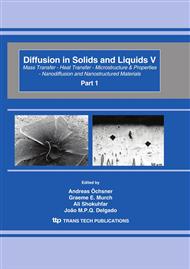p.859
p.864
p.869
p.875
p.881
p.887
p.893
p.899
p.906
Presentation of a New Method for Determination of Diffusion Coefficients of Gaseous Pollutants in Cladding Wall Materials Indoors
Abstract:
Diffusion and partition coefficients are two key parameters of importance for the characterization of building materials as sources and sinks of air pollutants indoors. The number of coefficients for each pair ‘chemical compound – material surface’ available in the literature are still scarce and with a high discrepancy in the results obtained by different methods, even for the same method [1]. The objectives of this study were (1) to develop a simple and rapid experimental method for directly measuring the diffusion coefficient (D), and (2) to perform determinations with both the new and the cup method comparing the results obtained. The new method is based on two existent methodologies, the passive sampling on Tenax TA and the dry cup method, proposed by Haghighat et al. [1] and also developed by this research team [2]. The experiments were carried for three different building materials (cork based material, gypsum board and PVC) and three different compounds (cyclohexane, n-octane and m-xylene). The discussion of the results obtained for D by the two methods is presented in this paper. Observed differences were not of the same order of magnitude for the pairs compound/material studied, varying from the order of 101 in the case of PVC to 102 in the gypsum and in the cork. However some facts were the same: the gypsum board presents the higher values of D and PVC the lower values of D for the three compounds studied in both methods. One of the causes of these marked differences could be high difference of the concentration of the compound in the air between the methods, saturation value in cup method (dozens g/m3) and low values typical from indoor environments (few mg/m3) in the proposed method.
Info:
Periodical:
Pages:
881-886
Citation:
Online since:
April 2010
Permissions:
Share:
Citation:


